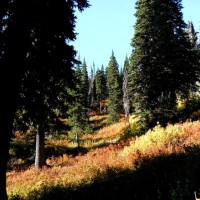GRIZZLY BASIN OUTFITTERS
BRITISH COLUMBIA
Preparing for your GBO Hunt
 Contract/Waiver and other useful information
Contract/Waiver and other useful information
The documents listed here are required by all hunters hunting with Grizzly Basin Outfitters. Please ensure that you have completed these forms in full prior to your hunt.
Please download and review the following PDF documents:
- Hunting Contract
- Grizzly Basin Outfitters –Liability Waiver
- Non-Resident Firearms Declaration Form
- Personal Information Form
 What to bring on your hunt
What to bring on your hunt
- Rifle or Bow + 2-3 boxes of ammunition
- Binoculars – 8-10 power, you will be spending a good deal of time glassing with your guide so high quality optics are a good investment
- Rangefinder
- Small headlamp – we use the Petzl Tikka headlamps
- Waterproof gaiters (keeps your legs and boots dry when walking through wet brush)
- Helmet or other safety or protective gear should you choose to wear this while riding horse, ATV, etc.
- Rain gear (very important) – as with binoculars, high quality rainwear is worth it – we suggest Gortex with a quiet finish – e.g., Cabela’s MTO50. Except for our late season moose, deer and mountain goat hunts, it is generally better to buy uninsulated rain gear and use it as an outer shell when necessary
- Hunting boots – stiff construction, waterproof – make sure to wear them and work them in before your trip. If you are looking to buy a pair, we recommend the Meindl Alaska Hunter boots from Cabelas.
- Personal Prescriptions/towel
- Camp shoes for after hours in cabins
- Gloves-insulated and water proof- 2 pairs
- Sleeping bag – lightweight down or synthetic warmth factor to 0 degrees – If you have a large sleeping bag, we suggest also bringing a compact one for outpost camps
- Daypack or fanny pack to carry lunch, rainwear when not in use. For the Sawtooth area, we also suggest a larger multi-day backpack with an external or internal frame.
- Camera & film
- Clothing-Usually 2 pairs of pants, denim, wool or fleece is sufficient – should fit loosely for comfort on horseback. Thermal underwear, outer shirts, socks, underwear- 2-3 sets in case of getting wet
Physical preparation
We are fortunate to have good hunting areas to accommodate a variety of physical capabilities of our guests. For example, some areas we can get quite close to on a 4X4 or ATV. We get as close as possible to our hunting areas and then hike. This may mean walking for several miles while hunting. In some areas of our territories, it may mean a difficult climb up a mountain each day. Talk to your doctor, physical trainer or an athletic coach for help in making a specific plan to prepare yourself for your hunt. Most important, let us know if your or anyone in your party would like to take advantage of these hunting areas that are less strenuous to access.
Nevertheless, physical preparation will make your hunting trip more enjoyable for a number of reasons.
- Physical fitness allows you walk better and farther. You'll be able to cover more of the hunting area with your guide and be able to access more remote sites
- Physical fitness helps you avoid exhaustion and dangerous lapses of concentration. Being alert and focused helps you avoid accidents like falls, and helps you pay attention to your firearm safety and shooting skills.
- Being fit, makes you a better shot, too - allowing you to be steady when you draw or sight in on your trophy.
We recommended that you try to include each of the three major components of exercise into your exercise routine: stretching, endurance and strengthening.
- Stretching: Warm up and stretch before any activity. Stretches help warm the muscles by getting blood flowing to them before demanding heavier work from them. Some people also stretch after the activity to help relax the muscles. Some suggested stretches include: trunk twist, knee hugs, calf stretches, hamstring stretches, and quadricep stretches.
- Endurance: Improve your endurance by regularly challenging your heart and lungs. This can be accomplished by briskly walking 15-30 minutes, 3 to 5 times each week. Jogging, swimming, or any other aerobic exercise choice will improve your physical fitness, but "walking in the woods" will be the best way to prepare you for "walking in the woods".
- Strengthening: Muscle strengthening can help us to feel that any activity is easier. Whether using hand weights, barbells, or other weight training equipment, remember to start slowly and increase gradually. It is best to begin with low weights and high repetitions (i.e. 12, 15, or 20 repetitions). Select a few upper body (i.e. biceps, triceps, shoulders) and a few lower body (quadriceps, hamstrings, calves) exercises. Add a few abdominal exercises into your routine as well.
Source: Hunt Alaska - Alaska Department of Fish & Game, Well Aware newsletter, by Ann Mattson and Darla Baumgarten,
Articles on Getting Prepared
LeMay Ivey, Eowyn, "A Fit Hunter is a Better Hunter", Frontiersman
